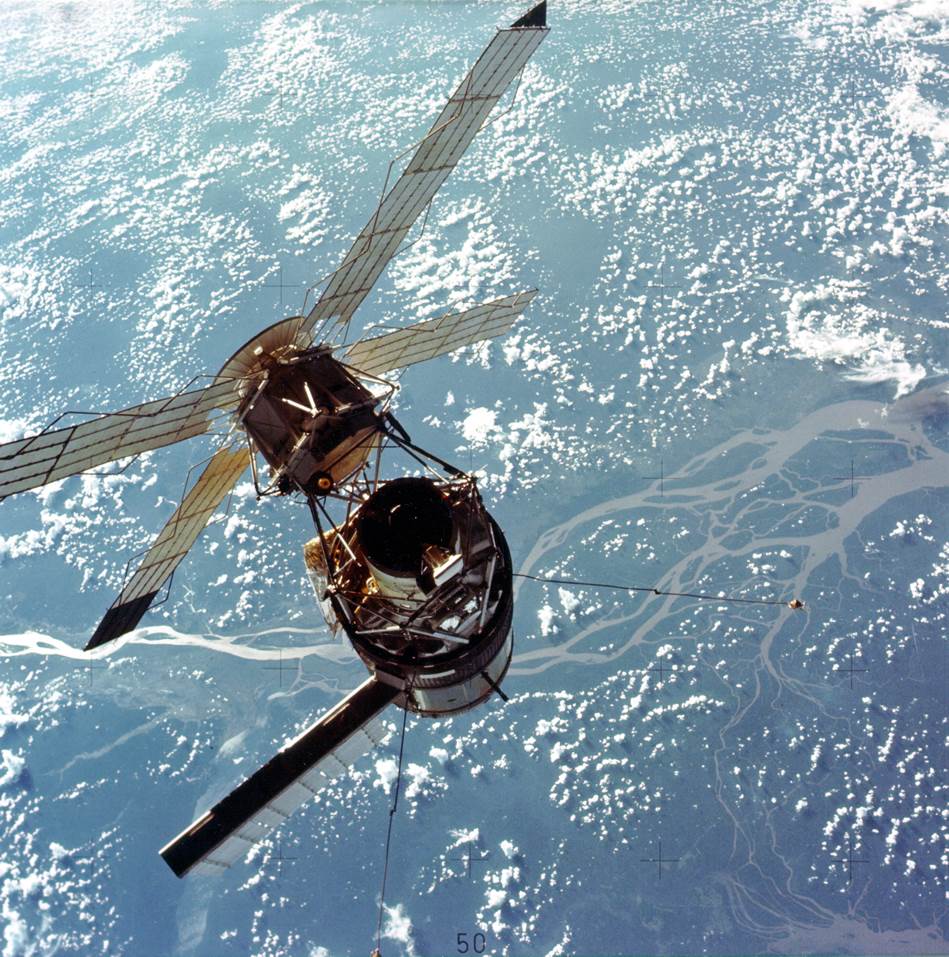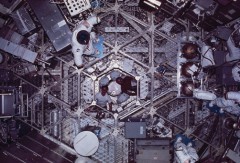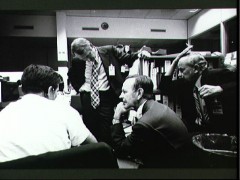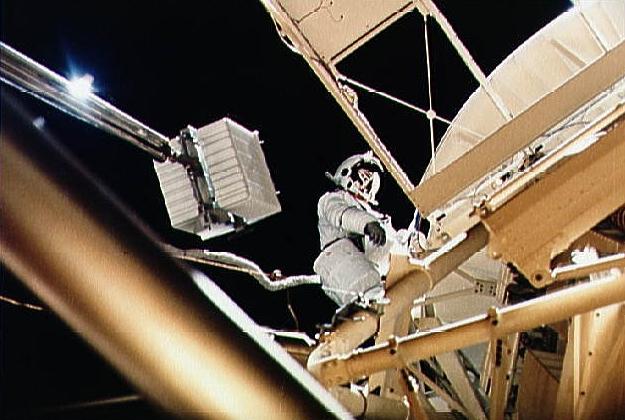
Forty years ago this summer, America’s first space station—Skylab—was boosted into orbit atop the last in a generation of mighty Saturn V rockets. During launch, however, disaster struck the mission, when the station’s micrometeoroid shield and one of its electricity-generating solar arrays were torn away in the aerodynamic slipstream and the first crew were faced with enormous difficulty to turning Skylab from a barely habitable hulk into their home for a month. They returned to Earth in late June 1973, leaving a vastly improved station for the next crew. On the second mission, Skylab 3, astronauts Al Bean, Owen Garriott, and Jack Lousma were tasked to spend a record-setting 59 days in orbit, more than twice as long as had been accomplished by any previous astronaut or cosmonaut. The mission would prove an enormous success … but that success could hardly have been imagined during Skylab 3’s first few unfortunate days.
Within hours of reaching orbit, on 28 July 1973, the attention of Bean and his men was captured by the blaring of the command module’s master alarm. It alerted them to unusually low temperatures in one of the Reaction Control System (RCS) thruster quads. All three men realized that a leak of either hydrazine fuel or nitrogen tetroxide oxidiser had most likely occurred in “Quad B,” one of four sets of RCS thrusters, spaced at 90-degree intervals around the circumference of the service module. It was not good that it had come during the rendezvous with Skylab and so early into their mission. They quickly set about shutting down the entire quad on Lousma’s side of the spacecraft. Data telemetered to the ground revealed a clear drop in pressure, as both the hydrazine and pressurizing helium rapidly fell to off-scale lows.
In the book Homesteading Space, co-authored by Garriott, it was noted that the “reduced authority” of having only three sets of available RCS quads meant Bean had to pulse the remaining thrusters for longer to achieve a perfect rendezvous with Skylab. “It really incapacitated us a lot,” Bean recalled in his NASA oral history. “The main effect we had was any time I did anything, we went off-attitude in the other axes.” For the entire crew, it was acutely disappointing. During training, their instructors had thrown hundreds of faults and failure scenarios and they had managed to overcome each one without so much as a blink of the eye or a bead of sweat on the brow. Now, said Bean, “we realised we were lucky we didn’t have some sort of explosion and blow that leaky quad thruster right off and really have a problem.”

The situation was complicated by the reality that, in 1973, devices to precisely measure a spacecraft’s closing range rate had not yet been invented. Owen Garriott, tasked with helping Bean to stick to the correct trajectory, had trained to use two range measurements from the on-board radar transponder at two different times, then had to divide the range difference by the time difference. By Garriott’s own admission it was imperfect, and it quickly became apparent that it was not slowing them down sufficiently to complete the rendezvous.
Still, Bean lauded Garriott as “a great ‘back-of-the-envelope’ guy,” capable of making accurate and rapid calculations and recommendations, but doubted his science pilot’s constant reminders that they were closing too fast and needed to apply more braking. The difference of opinion led Garriott, at one stage, to head down to the lower equipment bay, and that certainly got Bean’s attention. They were indeed closing too fast. Had it not been for Garriott’s admonitions, they would have closed too rapidly and sailed straight past Skylab, which would have necessitated a re-rendezvous, an unnecessary wasting of precious manoeuvring propellant and, in Bean’s eyes as the mission commander, would have been “real embarrassing.”
The astronauts’ first view of Skylab had come at a distance of more than 400 miles, and docking occurred a little under nine hours into the mission. From Lousma’s perspective, as he shot photograph after photograph during the rendezvous, it was both spectacular and unnerving; for the parasol erected by the station’s first crew looked decidedly flimsy. “It was flapping in the breeze … [of] the exhaust from our thrusters,” he told the NASA oral historian. “We thought we were going to blow it off, so we suspended the fly-around [inspection of Skylab] and went in and did the docking.”

Despite the good health of the station and—it seemed—the Apollo spacecraft, the first major obstacle quickly reared its head, when the astronauts fell victim to space sickness. The first affected was Lousma, who had begun experiencing the symptoms shortly after reaching orbit. He took a scopalomine-dextroamphetamine pill for anti-motion sickness and felt well enough to fulfil his duties during the rendezvous. However, very soon Bean and Garriott reported stomach “awareness” and were unable to move quickly around the interior of Skylab. At length, even with anti-motion-sickness medication, it was becoming difficult for the astronauts to prevent themselves from becoming ill.
Years later, Lousma vividly recalled that their arrival in the station exacerbated the problem. “We hadn’t spent a lot of time in … a volume [this large],” he recollected. “It was mostly in confined quarters, where you don’t have to move very much, but now we were climbing out of the command module and going through the tunnel into this big volume and we had all kinds of room to operate in and move around in.”
By the morning of 29 July, after a particularly unpleasant sleep, the breakfasts of Bean, Garriott, and Lousma were left partially eaten, and the astronauts found themselves behind with their timeline. A concerned Bean asked Mission Control for the opportunity to allow them to rest for a while and to move their first off-duty day forward from 3 August to 30 July; additionally, it was decided to postpone their first EVA by 24 hours. Originally, according to a detailed timeline published by NASA a few weeks earlier, no fewer than three EVAs were scheduled for the mission—on 31 July, 24 August, and 19 September—to install and retrieve film from the station’s Apollo Telescope Mount (ATM), but the first spacewalk was especially critical, since it would also involve the deployment of the Marshall Space Flight Center’s backup sunshade.
Bean’s crew had barely started their two-month mission and were already behind. Lousma would later admit to being perplexed at his unpleasant reaction to the space environment. He was a Marine, used to sickening aileron rolls and other stomach-churning aerial maneuvers and, along with his crewmates, had done a significant amount of training in rotating chairs on the ground, making various head movements to induce nausea and better “condition” themselves. It all appeared to have been for nothing. “Actually,” Lousma added, “on the ground, we were one of the most resistant crews to that kind of experience, but when we got in there, we were one of the least resistant!”

By 31 July, the men were feeling slightly better, and all were in finer spirits as August dawned—with Bean even demonstrating gymnastics to his television audience—although mission managers had by now elected to postpone the EVA a second time. Smaller meals were recommended in order to avoid nausea, but Bean would later argue that it was the timeline which was their real enemy. Everything they did took time—even finding new heads for their shavers—and as Houston sent more work to do, they found themselves bogged down with other tasks: troubleshooting Skylab’s balky dehumidifier, repairing the urine separator, and so on.
“Losing” things was a constant problem throughout the mission, since finding them again was quite unlike the chances of finding a lost item back on Earth. “We always seemed to look on hard surfaces,” said Garriott, “where we would normally have left it, but three-dimensional space is just too difficult to search visually.” After a while, they learned to start by checking the intake duct of the station’s air-circulation fans, where lint and debris—and, quite often, a few little items, pens, pencils, notes, and so on—would be rediscovered.
Aside from the time consumed by losing and having to find things, the sheer pace of that first week aboard Skylab was too hectic, and Bean was convinced that zooming around, unpacking equipment and supplies, and activating systems was aggravating their sickness. “We were not eating on time,” he explained, “we were not getting to bed on time, and we were not exercising.” All three, Bean felt, were absolutely crucial in ensuring a smooth adaptation from an Earthly lifestyle to the new environment, and he strongly advised the next crew to give them priority over the activation of the station. Space sickness was worrisome for other reasons, too. The space shuttle effort, approved by President Richard Nixon the previous year, envisaged seven-day missions in a spacecraft which offered a much larger volume than had previously been available. “Were we to lose three or four days out of each … flight because of motion sickness,” NASA Deputy Administrator George Low noted, “the entire shuttle effort would be in jeopardy.” It was not a minor issue.
Around six days after launch, Owen Garriott recalled they finally began to hit their stride. Then, another problem arose. And this time, it carried the potential to ruin their entire mission.
The next part of this article will appear next weekend.
Want to keep up-to-date with all things space? Be sure to “Like” AmericaSpace on Facebook and follow us on Twitter:@AmericaSpace



